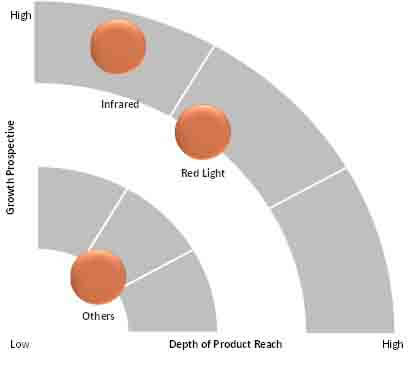ID: PMRREP23155| Upcoming | Format: PDF, Excel, PPT* | Healthcare

Photobiostimulation therapy is also known as low-level light therapy (LLLT). Photobiostimulating devices are used for reducing pain, inflammation, and edema, promoting the healing of wounds, deeper tissue, and nerves, and preventing tissue damage. Modern photobiostimulation devices use LEDs to produce light of the required wavelength to achieve specific results.
The predominant principle on which photobiostimulation devices work is that, light works on a protein in the mitochondria of the cell, which results in increased ATP and reduced oxidative stress. A cascade of intracellular processes finally results in improved tissue and reduced inflammation.
There are many types of photobiostimulation devices. They can be categorized based on the wavelength they emit. The most common types of photobiostimulation devices are the ones that have LEDs that emit infrared and red light. Some of the other lights include yellow and blue lights that significantly have applications in beauty therapy. However, these wavelengths are not broadly studied as that of infrared and red.
A number of small- and medium-sized companies dominate the market, since regulations for the manufacturing of photobiostimulation devices are quite lenient. Some of these companies include Thor Photomedicine Ltd, Bioflex Laser Therapy, Ingeneus Pty. Ltd., LumiWave, and Biolight Technologies.
Factors such as the increasing trend of non-invasive treatment alternatives, increasing number of patients experiencing chronic pain, and the need for cheaper treatment options are driving the growth of the photobiostimulation devices market.
However, although the treatment using photobiostimulation devices is FDA approved, the regulations governing the manufacturing of these devices are relatively lenient, resulting in a number of inferior quality products in the market. Furthermore, there are a number of counterfeit products available in the market, which is hindering the overall growth of the photobiostimulation devices market.
Infrared light photobiostimulation devices have shown positive results for increasing vascularization, deep thermal increase, increase in oxygenation, stimulation of the synthesis of new collagen, and improvement in skin elasticity.
Photobiostimulation devices that emit infrared light are commonly used in some of the pain management clinics and are well-studied for wound healing.
Photobiostimulation devices aim to accelerate wound healing and reduce the incidences of infection in diabetic foot ulcers. Especially since there is no particular treatment for diabetic foot ulcers, and the condition generally results in infections and complications that lead to amputation, photobiostimulation devices are effective for the treatment.
Photobiostimulation devices emit light that stimulates vascularization and internal heat, resulting in the faster recovery of wounds. The added advantage of using photobiostimulation devices is that, they are non-invasive in nature and easy to use.

North America is the leading region for the photobiostimulation devices market. This is due to many market players in the region, and the trend of using technologically advanced minimally invasive therapies that is prevalent in the region. Asia Pacific is the fastest growing region, as the manufacturing cost of photobiostimulation devices is very low, and there are a number of researches being undertaken in the region.
The photobiostimulation devices market is highly fragmented, and a large number of small players dominate the market. Most of the companies have focused application. For instance, HairMax offers products for hair growth only. Similarly, LumiWave’s products are focused on pain relief.
| Small-scale Manufacturers/Providers |
|
| Medium-scale Manufacturers/Providers |
|
| Large-scale Manufacturers/Providers |
|
The report covers exhaustive analysis on:
PMR utilizes a triangulation methodology that is primarily based on experimental techniques such as patient-level data, number of procedures, and capital equipment install base to obtain precise market estimations and insights on various medical devices and medical technology.
The bottom-up approach is always used to obtain insightful data for specific countries/regions. Country-specific data is again analysed to derive data on a global level. This methodology ensures the high quality and accuracy of information.
Secondary research is used at the initial phase to identify the feasibility of the target products/technology categories and its respective segments, product offerings, usage pattern as per disease indications, product installed base in target healthcare facilities, lifespan of a device, reimbursement scenario, adoption rate, and future impact of new technologies.
Each piece of information is eventually analysed during the entire research project, which builds a strong base for the primary research information.
Primary research participants include demand-side users such as key opinion leaders, physicians, and surgeons, and supply-side providers of medical devices who provide valuable insights on trends, key treatment patterns, adoption rates, purchasing patterns, technological development of medical devices, patient education, effectiveness of manufacturers and important strategies, pricing, and competitive dynamics.
Quantitative and qualitative assessment of basic factors driving demand, economic factors/cycles, and growth rates and strategies utilized by key players in the market are analysed in detail while forecasting, in order to project year-on-year growth rates. These Y-o-Y growth projections are checked and aligned as per industry/product lifecycle, and further utilized to develop market numbers at a holistic level.
On the other hand, we also analyse the annual reports_bk_01_01_2020 of various companies, investor presentations, SEC filings, 10k reports_bk_01_01_2020, and press releases operating in this market segment, to fetch substantial information about the market size, trends, opportunities, drivers, and restraints, and to analyse key players and their market shares. Key companies are segmented on a tier level based on their revenues, product portfolio, and presence.
Please note that these are the partial steps that are being followed while developing the market size. Besides this, forecasting will be done based on our internal proprietary model, which also uses different macro-economic factors such as per capita healthcare expenditure, disposable income, industry-based demand driving factors impacting the market, and forecast trends apart from disease-related factors.
|
Type |
|
| Application |
|
| End User |
|
|
Region |
|
Delivery Timelines
For more information on this report and its delivery timelines please get in touch with our sales team.
About Author